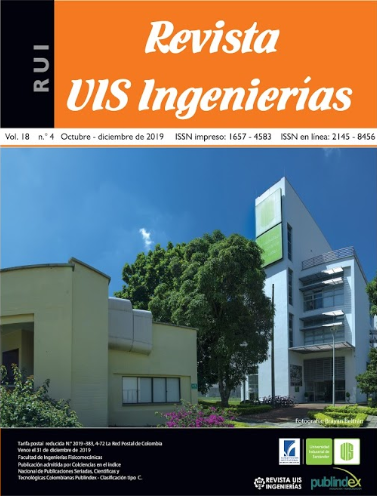Anomalies detection in the stability control of an aircraft
Published 2019-08-09
Keywords
- classification algorithms,
- aircraft control,
- servo control,
- support vector machines,
- state-space model
How to Cite
Copyright (c) 2019 Revista UIS Ingenierías

This work is licensed under a Creative Commons Attribution-NoDerivatives 4.0 International License.
Abstract
This paper presents a detection system which generate an alarm if exist an anomaly state in the stability control system of an aircraft. A servo type controller with integrator for the regulation of the Roll, Pitch and Yaw was designed starting from the lateral longitudinal and dimensional model. The models are excited with steps of random sizes and disturbed with different random signals to generate the database of suitable and non-suitable states. Radial base classifiers were trained and validated for its use in the detection of anomalous behaviors that may occur in the aircraft stability. The accuracy obtained with the classifiers was greater than the 93.33% for all the variables studied, indicating that classification techniques used, offer reliability in the determination of anomalous States in the simulation of the flight of the aircraft and that could be used in reall flights.
Downloads
References
[2] La Razón, «La Razón,» 12 Abril 2015. [En línea]. Available: http://www.razon.com.mx/spip.php?article255760.
[3] M. G. Skarpetis, F. N. Koumboulis, and A. S. Ntellis, “Longitudinal flight multi condition control using robust PID controllers,” in IEEE 16th Conference on Emerging Technologies & Factory Automation, ETFA, 2011, pp. 1–7. doi: 10.1109/ETFA.2011.6059071.
[4] Z. Ren, W. Wang, and Z. Shen, “New robust fault-tolerant controller for self-repairing flight control systems,” J. Syst. Eng. Electron., vol. 22, no. 1, pp. 77–82, 2011, doi: 10.3969/j.issn.1004-4132.2011.01.009.
[5] D. Viúdez-Moreiras, I. Martín, and J. M. Martín-Sánchez, “A new pitch angle adaptive control design,” in 2014 International Conference on Unmanned Aircraft Systems (ICUAS), 2014, pp. 928–935. doi: 10.1109/ICUAS.2014.6842342
[6] K. E. Terrell and S. Zein-Sabatto, “Integrated fuzzy controllers for aircrafts under faulty flight conditions,” in IEEE SOUTHEASTCON 2014, 2014, pp. 1–6. doi: 10.1109/SECON.2014.6950679
[7] N. Wahid and M. F. Rahmat, “Pitch control system using LQR and Fuzzy Logic Controller,” in 2010 IEEE Symposium on Industrial Electronics and Applications (ISIEA), 2010, pp. 389–394. doi: 10.1109/ISIEA.2010.5679436.
[8] A. H. Bajodah, H. Mibar, and U. Ansari, “Aircraft Motion Decoupling of Roll and Yaw Dynamics Using Generalized Dynamic Inversion Control,” in 2018 26th Mediterranean Conference on Control and Automation (MED), 2018, pp. 1–9. doi: 10.1109/MED.2018.8442505.
[9] G. Călugăru and E. Dănişor, “Improved aircraft attitude control using generalized predictive control method,” in 2016 17th International Carpathian Control Conference (ICCC), 2016, pp. 101–106. doi: 10.1109/CarpathianCC.2016.7501075.
[10] E. E. Galarza, C. A. Naranjo, O. Guijarro, D. Basantes, V. Enriquez, and D. Paredes, “Control algorithm for the inertial stabilization of UAVs,” in 2017 Annual IEEE International Systems Conference (SysCon), 2017, pp. 1–6. doi: 10.1109/SYSCON.2017.7934763.
[11] T. Hongpeng and Weibo, “Stability Control of Flight Attitude Angle for Four Rotor Aircraft,” in 2018 IEEE 9th International Conference on Software Engineering and Service Science (ICSESS), 2018, pp. 332–336. doi: 10.1109/ICSESS.2018.8663726.
[12] J. Shi, H. Yan, and X. Liu, “Multi-dimensional Taylor Network Optimal Control in Plane Symmetrical Cruise Missile Flight for Attacking Static Targets,” in 2018 IEEE 3rd Advanced Information Technology, Electronic and Automation Control Conference (IAEAC), 2018, pp. 457–462. doi: 10.1109/IAEAC.2018.8577696
[13] J.-P. Shi, J.-W. Liu, B. Lan, and P. Yang, “Adaptive variable structure control of flight control system,” in 2016 IEEE Chinese Guidance, Navigation and Control Conference (CGNCC), 2016, pp. 648–651. doi: 10.1109/CGNCC.2016.7828863.
[14] V. B. Larin and A. A. Tunik, “Synthesis of the quad-rotor flight control system,” in 2016 4th International Conference on Methods and Systems of Navigation and Motion Control (MSNMC), 2016, pp. 12–17. doi: 10.1109/MSNMC.2016.7783095.
[15] X. Yu, Y. Fu, P. Li, and Y. Zhang, “Fault-Tolerant Aircraft Control Based on Self-Constructing Fuzzy Neural Networks and Multivariable SMC Under Actuator Faults,” IEEE Trans. Fuzzy Syst., vol. 26, no. 4, pp. 2324–2335, 2018. doi: 10.1109/TFUZZ.2017.2773422.
[16] Y. Zhang, G. Tao, M. Chen, and X. Lv, “Adaptive control of uncertain nonlinear aircraft systems using combined linearized models,” in 2016 IEEE Chinese Guidance, Navigation and Control Conference (CGNCC), 2016, pp. 1156–1161. doi: 10.1109/CGNCC.2016.7828951.
[17] Y. Osa, S. Uchikado, and K. Tanaka, “Pitch angle control for hovering tilt rotor aircraft on one side rotor lift variation,” in 2017 International Automatic Control Conference (CACS), 2017, pp. 1–5. doi: 10.1109/CACS.2017.8284254.
[18] O. Vila Rovira, Modelización de aeronaves no tripuladas con Simulink. 2011.
[19] L. E. García Jaimes, Sistemas De Control Avanzado, 3ra ed. Politécnico Colombiano, 2013.
[20] K. Duan, S. S. Keerthi, and A. N. Poo, “Evaluation of simple performance measures for tuning SVM hyperparameters,” Neurocomputing, vol. 51, pp. 41–59, 2003.
[21] G. A. Betancourt, “Las Máquinas De Soporte Vectorial (SVMs),” Sci. Tech. Vol. 1, Núm. 27, vol. 1, no. 27, 2005. doi: 10.22517/23447214.6895.
[22] J. Á. Resendiz Trejo, “Las maquinas de vectores de soporte para identificación en línea,” Instituto Politécnico Nacional, 2006.
